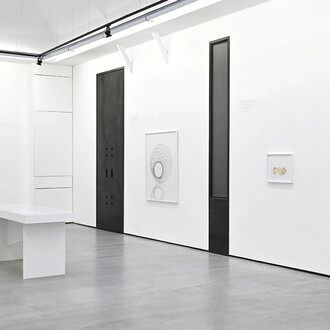There is an American artist whose artistic practice has its roots in architecture, in minimalism, in conceptualism, in the aesthetics of bricolage, in Land Art ... His works are built on precarious balances in close relationship with the space that hosts them and with the observer always strongly involved in order to stimulate a widespread sense of collectivity.
Oscar Tuazon's Water School is on display at the Galerie Chantal Crousel in Paris until July 24, 2021. But what exactly is this Water School? It is a project in progress that includes works and public debates that explore the dynamics and power games that regulate some fundamental human rights such as access to water (the Universal Declaration of Human Rights states: "Water is a essential right for human life"), to land and infrastructure. According to the WWF, today over a billion people cannot rely on a continuous supply of water while 2.4 billion (one third of the world population) do not have adequate sewage systems available.
There are several water schools created by the American artist in the world and housed in a plywood structure inspired by Steve Baer's Zome House, a particular architecture that absorbed heat without any carbon footprint. Cedar Spring Water School reflects on the Cedar Spring in Nevada. Located in the high desert of the Great Basin, Cedar Spring is one of hundreds of Spring Valley freshwater springs threatened by the proposal to build an expensive pipeline to drain water in the valley 360 miles south of Las Vegas. "Cedar Spring Water School is a public art project guided by Indigenous ecological knowledge to connect people through the medium of water. Water School moves, following water as it cycles across vast geographies, linking mountains to oceans and subterranean aquifers to the skies above them. From Albuquerque to Zürich; Los Angeles to White Earth, Minnesota; the Great Lakes to the Salish Sea; Cedar Spring to Paris: Water School is a mobile architecture, learning from the fluidity of its medium and the collaborative process of its construction," Oscar Tuazon.
For his exhibition at Galerie Chantal Crousel, Oscar Tuazon presents a series of new works related to the Water School project. These include a set of powder-printed windows that echo the architecture of the physical structure of the School of Water ("I work in the interior space of a window, that space between the two sheets of glass in a dual pane window, a narrow field of refracted light where energy is instantiated," Oscar Tuazon).
Wood and stainless steel stoves are also exhibited. "There is a fire at the core of all architecture, the cultural aspect of building by which the inhabitants of a structure are responsible to the resources on which they depend, tied to outside. Under the accelerating effects of global heating, fire looms as a threat beyond our control, transforming into a sinister weapon, wildfire. Can we tame flame, our primary human tool? The rocket stove is a low-tech experiment—efficient fire consuming its emissions, burning its own smoke."
There are numerous solo shows dedicated to Tuazon, among these we remember: Aspen Museum of Art (2019); Bellevue Art Museum, Seattle (2019); Hammer Museum, Los Angeles (2016); Le Consortium, Dijon (2015); deCordova Sculpture Park and Museum, Lincoln (2014); Museum Ludwig, Cologne (2014); Museum Boijmans Van Beuningen, Rotterdam (2013); Schinkel Pavillon, Berlin (2013); Kunsthalle Bern (2010) and the Centre international d’art et du paysage, Île de Vassivière (2009).
Among the group shows: Chicago Architecture Biennial (2019); Skulptur Projekte, Münster (2017); Documenta 14, Athens (2017); Triennale d'art contemporain de Beaufort (2015); Whitney Biennial (2012); and the Venice Biennale (2011).

















